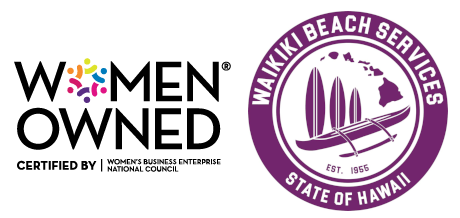Waikīkī’s Surf Breaks and the Legends They Carry
By Emma Susas
Waikīkī is more than just a world-famous beach—it’s a place of deep cultural significance, rich history, and powerful moʻolelo. The waves we surf today carry the names and stories of those who came before us.
Here are the original Hawaiian names and the moʻolelo behind some of Waikīkī’s most well-known surf breaks:
Kapuni (Canoes)
While you may know the popular surf break Canoes, its original Hawaiian name is Kapuni.
In the 1500s, four powerful healers from Tahiti—Kapaemāhū, Kapuni, Kinohi, and Kahaloa—arrived in Waikīkī. These healers were mahu, individuals embodying both male and female spirits, and were deeply respected for their extraordinary healing abilities. They settled in an area known as Ulukou, near where the Royal Hawaiian and Sheraton Waikīkī hotels now stand.
As they traveled across the island, their fame grew through the miraculous cures they provided. Before returning to their homeland of Raiatea, the healers requested that two stones be placed at their Ulukou residence and two at their favorite bathing place in the sea.
The stones were quarried from Kaimukī and carried by thousands to Ulukou on the sacred night of Kāne. Before their departure, the healers transferred their names and mana (spiritual power) into the stones, leaving a legacy that still resonates through Waikīkī’s shoreline today.
Kawehewehe (Populars)
Today’s surf break, known as Populars, was initially called Kawehewehe, meaning “the removal.”
This stretch of beach and surf break fronting the Sheraton Waikīkī was an ancient healing site. Kawehewehe was a place where physical and spiritual healing took place, powered by the belief in the sea’s cleansing abilities.
Those who were sick or injured would come to bathe in the kai (sea), adorned with lei of limu kala. They would leave the lei in the water as a symbol of asking for forgiveness for past sins, which were believed to cause illness.
The beach within the area is now known as Grayʻs Beach. The natural sand-filled channel that runs through the reef makes it one of the best swimming areas in Waikīkī. There are natural springs that are sometimes exposed in the sand. You can feel the freshwater through cold spots in the ocean that remind us of Waikīkī’s translation: “spouting fresh water.”
Kalehuawehe (Castles)
What we now call Castles was once known as Kalehuawehe.
According to legend, a young chief named Pīkoiakaʻalalā paddled out wearing a lei of lehua blossoms. His handsome looks caught the eye of Chiefess Kahamaluʻihi, who followed him out on her board. The two drifted to another surf spot–one with no name, as it rarely had waves.
The Chiefess said, “I think I’d look fine with your lei.”
He protested, “My lei are free for all. How can they be good enough for you? You are an ali’i.”
She replied, “If anyone has a lei and I wear it on my head, it becomes mine.”
So he removed his lei and tied it around her neck. She smiled, smelled the lehua, and the surf spot became known as Kalehuawehe, which means “the removed lehua”.
ʻĀpuakēhau & Helumoa
Before the Ala Wai Canal was built in 1928, Waikīkī was a 2,000-acre marshland fed by streams like ʻĀpuakēhau, which means “basket of dew.”
This stream flowed through the land where the Royal Hawaiian Hotel, Sheraton Waikīkī, and the Royal Hawaiian Grove stand today. Surfers would rinse off in its waters, and its freshwater carved a natural channel between the Canoes and Populars surf breaks, preventing coral growth and shaping the shoreline.
ʻĀpuakēhau flowed through a legendary coconut grove known as Helumoa. According to moʻolelo, a supernatural rooster named Kaʻauhelemoa flew from Kaʻau Crater and landed at the feet of Chief Kākuhihewa. It scratched the earth and vanished, seen as a divine sign. The chief planted a coconut tree where the rooster scratched, leading to a grove of 10,000 trees. The area became known as Helumoa, meaning “chicken scratch.”
Why These Stories Matter
The waters of Waikīkī are more than surf breaks and sunbathing spots. Each name tells a story, and knowing these stories connects us more deeply to the land, the ocean, and the people who came before us.
As we enjoy the waves today, may we also honor the names, places, and moʻolelo that give them life.




